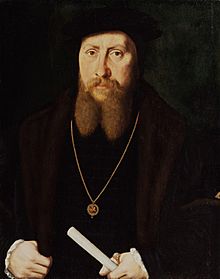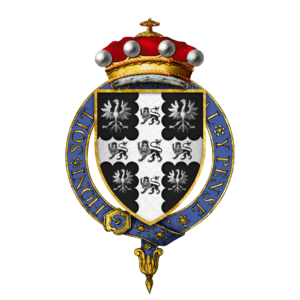William Paget, 1st Baron Paget facts for kids
William Paget (1506–1563) was an important English leader who worked for three different kings and queens: King Henry VIII, King Edward VI, and Queen Mary I. He was known as the 1st Baron Paget.
Quick facts for kids
The Lord Paget
|
|
|---|---|

Painting of William Paget, attributed to Master of the Stätthalterin Madonna
|
|
| Born | 1506 |
| Died | 9 June 1563 West Drayton
|
| Education | St Paul's School, Trinity Hall, Cambridge and University of Paris |
| Occupation | several diplomatic missions |
| Spouse(s) | Anne Preston |
| Children | Henry Paget, 2nd Baron Paget Thomas Paget, 3rd Baron Paget Charles Paget Edward Paget Etheldreda Paget Eleanor Paget Grisold Paget Joan Paget Dorothy Paget Anne Paget |
| Parent(s) | John Paget Anne Paget |
Contents
Early Life and Education
William Paget was born in Staffordshire in 1506. His father, John Paget, worked for the city of London.
William went to school at St Paul's School in London. There, he became friends with John Leland, who would later become a famous historian. William also studied at Trinity Hall, Cambridge, and later at the University of Paris.
Starting a Political Career
William Paget began his career in government. He served as a Member of Parliament for Lichfield in 1529. Later, he represented Middlesex in 1545.
A powerful friend, Stephen Gardiner, helped Paget get important jobs. King Henry VIII sent him on several diplomatic trips. These trips involved talking with leaders from other countries.
In 1532, Paget became a Clerk of the Signet. This was an important role in the king's office. Soon after, he joined the Privy Council, a group of the king's closest advisors.
Working for King Henry VIII
William Paget became secretary to Anne of Cleves in 1539. She was one of King Henry VIII's wives. In 1541, he was made Clerk of the Parliaments. This job involved keeping records for the government.
By 1543, he was a full member of the Privy Council. He also became Secretary of State. King Henry VIII trusted Paget's advice a lot. Before he died, Henry VIII chose Paget to be part of the council that would help rule while his young son, King Edward VI, was still a child.
Serving King Edward VI
When King Edward VI became king, William Paget supported Edward Seymour, who was the young king's protector. Paget tried to advise Somerset to be more open to other people's ideas. He wrote letters to Somerset, encouraging him to listen to others.
Paget was worried that Somerset's way of leading was causing problems. In 1547, Paget received many honors. He became controller of the king's household. He also became Chancellor of the Duchy of Lancaster. He was elected as a Member of Parliament for Staffordshire. He was also made a knight of the Garter, a very special award.
In 1549, Paget became Baron Paget de Beaudesert. This meant he joined the House of Lords. He also received a lot of land, including Cannock Chase and Burton Abbey. He also got Beaudesert in Staffordshire, which became the main home for his family.
Challenges and Later Years
Paget faced difficulties when Somerset lost power. In 1551, Paget was sent to the Tower of London. He also lost his Knight of the Garter title. He had to pay a large fine because of some actions related to his work.
However, he regained the king's favor in 1553. He was one of the leaders who signed a document to make Lady Jane Grey queen. But he soon made peace with Queen Mary I. She brought him back into her favor. In 1553, she made him a Knight of the Garter again. She also brought him back to the Privy Council. In 1556, he became Lord Privy Seal, another important government job.
When Queen Elizabeth I became queen in 1558, Paget decided to retire from public life.
Paget's Family
William Paget and his wife, Anne Preston, had four sons and five daughters.
His two oldest sons, Henry and Thomas, inherited his title one after the other. Henry was even given the title of Baron Burton during his father's lifetime. Another son, Charles, was known for being involved in secret plans during Queen Elizabeth I's reign. Thomas was also suspected of being involved in some of Charles's activities.


